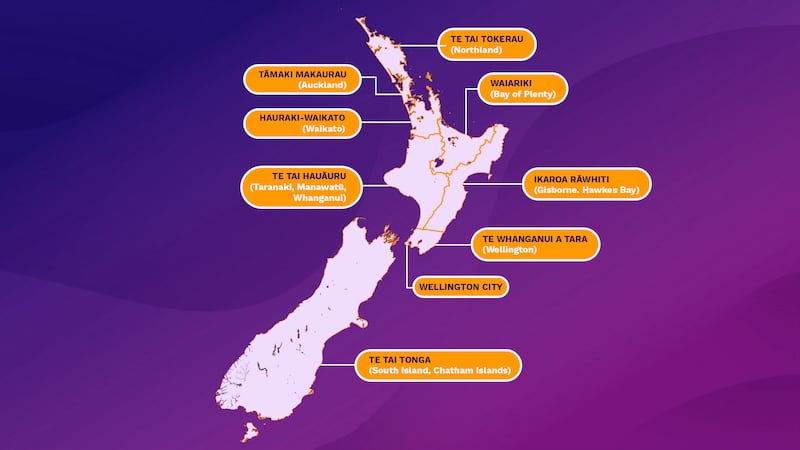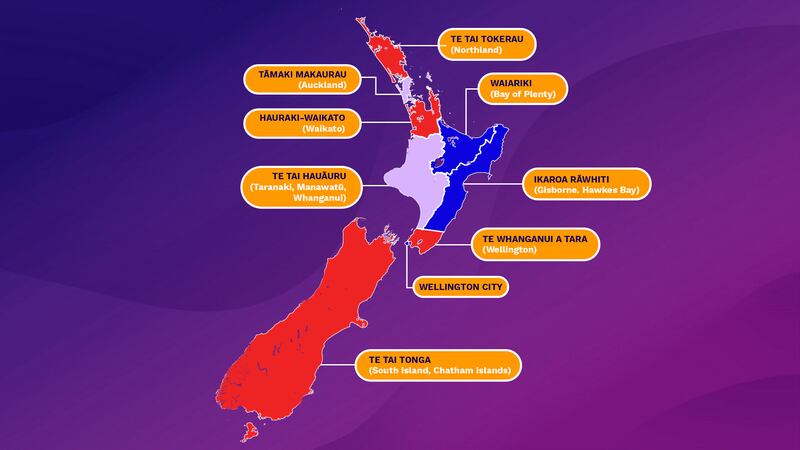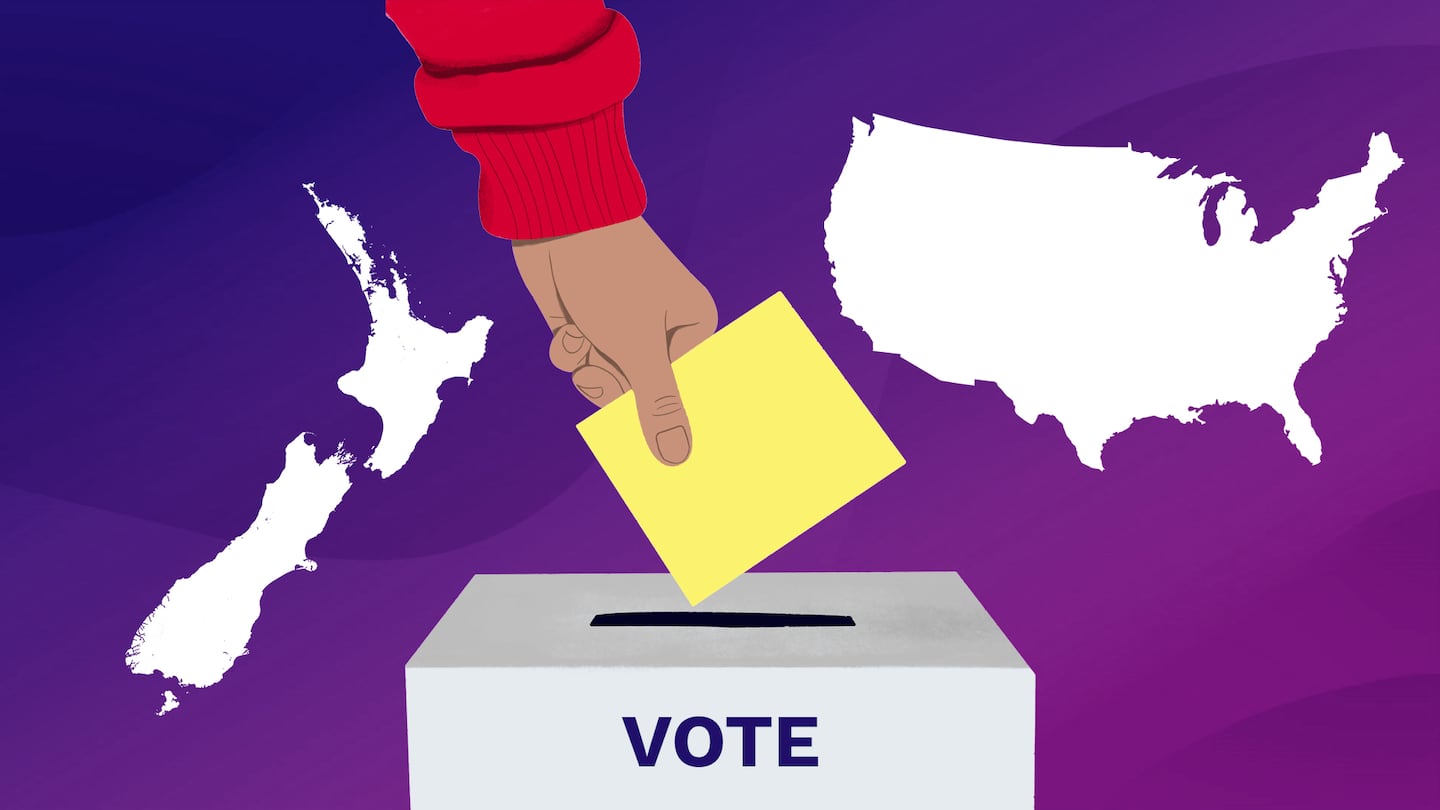In most western democracies, the winner of an election is the one with the most votes. But it doesn’t work like that in the United States.
The Americans use a system called the Electoral College, which is a complicated kaupapa that needs lot of explaining.
Some countries use a variation of the Electoral College to pick their leader but not in the way the US does.
To try to explain it, instead of putting it in American terms, Te Ao Māori News decided to explain it using Aotearoa as an example to see what it would look like if this country used the ways of the US.
Aotearoa ‘states’
There are 50 states in the US, some of which are significantly larger than New Zealand.
In our example, we will be using the Māori electorates as our ‘states’ but adjusting them just a little and adding an extra one.
- Te Tai Tokerau - Northland region (Removing north Auckland)
- Tāmaki Makaurau - Auckland region (Adding north Auckland)
- Hauraki-Waikato - Waikato region (including Taupo)
- Waiariki - Bay of Plenty region (excluding Taupo)
- Ikaroa-Rāwhiti - Gisborne and Hawkes Bay (excluding east of the Wellington region)
- Te Tai Hauāuru - Taranaki and Manawātu Whanganui region (excluding north of the Wellington Region.)
- Te Tai Taonga - South Island and Chatham Islands (excluding Wellington City)
- Te Whanganui a Tara - Wellington region (excluding Wellington city) This is not a real Māori electorate; it has been included in this article as an example.

You may have noticed that Wellington City isn’t part of any state. This is similar to the U.S., where the capital, Washington, D.C., is not part of any state but is its own jurisdiction. As a result, during elections, the city receives its own electoral votes.
Electoral votes
Now that we have established our states, we can get to the juicy part of the explanation.
In the US, for a candidate to win the election, they must get 270 electoral votes out of 538.
The number 538 might seem random but it is made up from 435 members in the US House of Representatives, 100 senators, and three electoral votes allocated to Washington, DC. The 23rd Amendment to the U.S. Constitution grants DC electoral votes, stating that it must have the same number of votes as the least populous state, which also has three.
Every state gets two senators, while the number of representatives each state has in the House varies based on population size.
This combination influences how many electoral votes each state gets, as a state’s total electoral votes are equal to the number of its representatives plus its two senators.
For our example, we will split the 123 MPs in the Beehive into representatives and senators. This will result in 107 representatives and 16 senators distributed among the eight states.
For those wondering how we did the math, you can see our reasonings at the end of the article.
| State | Representatives | Electoral votes (plus senators) |
|---|---|---|
| Te Tai Tokerau | 9 | 11 |
| Tāmaki Makaurau | 26 | 28 |
| Hauraki-Waikato | 15 | 17 |
| Waiariki | 13 | 15 |
| Ikaroa-Rāwhiti | 9 | 11 |
| Te Tai Hauāuru | 11 | 13 |
| Te Whanganui a Tara | 7 | 9 |
| Te Tai Taonga | 17 | 19 |
Following the model of the 23rd Amendment in the US constitution, Wellington City would have nine electoral votes. This brings the total number of electoral votes to 132, meaning a candidate would need 67 electoral votes to become the ‘president’ of Aotearoa.
One vote ≠ one vote
In many countries, leaders are chosen by whoever wins the most votes but, with the Electoral College, it becomes more complex.
Only five presidents in US history have won the 270 electoral votes but not the popular vote.
- John Quincy Adams (1824)
- Rutherford B. Hayes (1876)
- Benjamin Harrison (1888)
- George W. Bush (2000)
- Donald Trump (2016)
This is due to a vote in one state not always carrying the same weight as a vote in another.
Using the data above, we found that one electoral vote in Aotearoa should represent 7,410.95 Māori. However, the table below shows discrepancies from this ideal ratio.
| State | One electoral vote per Māori (2DP) |
|---|---|
| Te Tai Tokerau | 7043.18 |
| Tāmaki Makaurau | 8139.21 |
| Hauraki-Waikato | 8102.47 |
| Waiariki | 7330.20 |
| Ikaroa-Rāwhiti | 7468.91 |
| Te Tai Hauāuru | 7647.92 |
| Te Whanganui a Tara | 7358.33 |
| Te Tai Taonga | 8149.10 |
| Wellington City | 2505.00 |
Looking at the data, the closest to the one electoral vote per 7,410.95 Māori is Te Whanganui a Tara, which has 52.62 fewer Māori than the ideal ratio.
Wellington City is the furthest from the average, with 4,905.95 fewer Māori, and also has the lowest ratio. Te Tai Taonga, on the other hand, has the highest ratio, meaning a vote in the capital city has more weight than a vote from someone living in the South Island.
This is similar to the problems some states in the US have today, when it comes to the electoral college.
The only time the popular vote matters is within each state. Hypothetically, if Te Tai Tokerau, with its 11 electoral votes, had 45% voting blue and 46% voting red, all 11 electoral votes would go to red, as they are not split based on the vote share.
Spilt electoral vote states
There are only two states in America, Maine and Nebraska, where the winner does not take it all. Instead, only two electoral votes from both go to the popular winner while the others are scattered to their congressional district.
This is referred to as the congressional district method, which basically splits the electoral votes.
If New Zealand were using the electoral college system, and Ikaroa-Rāwhiti decided to adopt this method, we could consider the Gisborne and Hawke’s Bay regions as their own districts. Ikaroa-Rāwhiti would have 11 electoral votes, with three votes going to the overall popular winner, while Gisborne and Hawke’s Bay would each decide to whom they would allocate their four electoral vote.
During the 2020 US elections, Biden won the state wide vote in Maine and the first congressional district meaning he received three electoral votes. The second distracted backed Trump giving him only one electoral vote.
Swing states
Many believe winning some big ticket states could get you an automatic win, but sometimes it is all in the states that could go either way, we call these ‘swing states’.
They are the only obstacle that stops many presidential nominees from getting a hold of the keys to the white house.
In the 2024 elections, there are seven of them - Arizona, Georgia, Michigan, Nevada, North Carolina, Pennsylvania and Wisconsin -collectively they hold 93 electoral votes.
During the election, they won’t be considered a blue or red state but instead a purple state.
In Aotearoa’s hypothetical election, we have randomly chosen Tāmaki Makaurau and Te Tai Hauāuru holding 41 electoral votes.

In the photo above, the Reds would only need Te Tai Hauāuru to win the election, with the Blue party needing both states to receive the power.
These areas would be places the presidential nominees would campaign the hardest in to try to push the scales into their favour.
Is it democratic?
In America and sometimes outside the US, it is debated whether this system used since the founding fathers is still democratic.
In a trusty Collins dictionary found in the Whakaata Māori Newsroom Democracy means:
“A system of government or organisation in which the citizens or members choose leaders or make other important decisions by voting.” and “A country in which the citizens choose their government by voting.”
Under this definition, the Electoral College is technically democratic. However, many still consider it undemocratic; for instance, Jesse Wegman, a member of the New York Times editorial board, described it as undemocratic in this 2020 article.
“Despite what you may have learned in school, it was not the product of careful design by brilliant men. Thrown together at the last minute by the country’s founders, it almost immediately stopped functioning as they thought it would. And yet we have generally accepted it for centuries on the assumption it serves an important purpose.
“It doesn’t.
“We have an Electoral College because that’s what the founders added to the constitution at the last minute.
“This isn’t a partisan issue — it’s a fairness issue. Whether you’re Republican or Democrat, your vote probably doesn’t count the way it should. It doesn’t have to be this way," Wegman said.
This contrasts with a 2021 article by CBS News, where Tara Ross, author of The Indispensable Electoral College, argued that the current system encourages presidential candidates to court the votes of a more diverse electorate across the US.
“We have a system where you have to win simultaneous victories in multiple parts of the country and the only way to get there is to build the biggest coalition you can,” Ross said. “Because of the Electoral College, presidential candidates serve themselves best if they try to appeal to a wide variety of people,” she told CBS News.
Research done by the Pew Research Center showed more than six in ten Americans prefered the president to win the popular vote over the electoral college.
How we worked out the figures
For those interested in how we calculated this complex kaupapa, here are our workings:
In the first table, to determine the electoral votes per ‘state’ in Aotearoa, we used the Māori population of 978,246 from the recent Census data. We subtracted Wellington City’s Māori population of 22,545 from this total, resulting in a new population of 955,701. This figure was used to calculate the number of representatives for each state.
Dividing 955,701 by 107 gives us 8,931.8 Māori per representative (rounded to one decimal place). We then applied this ratio to each state’s population, using the same Census data but, broken down into regions, to determine the number of representatives for each state.
For the second table, we calculated that one electoral vote should represent 7,410.95 Māori, by dividing the total Māori population by the total electoral votes (978,246/132). To find the ratio for each state’s electoral vote to its Māori population, we divided each state’s population by the number of electoral votes they received.




